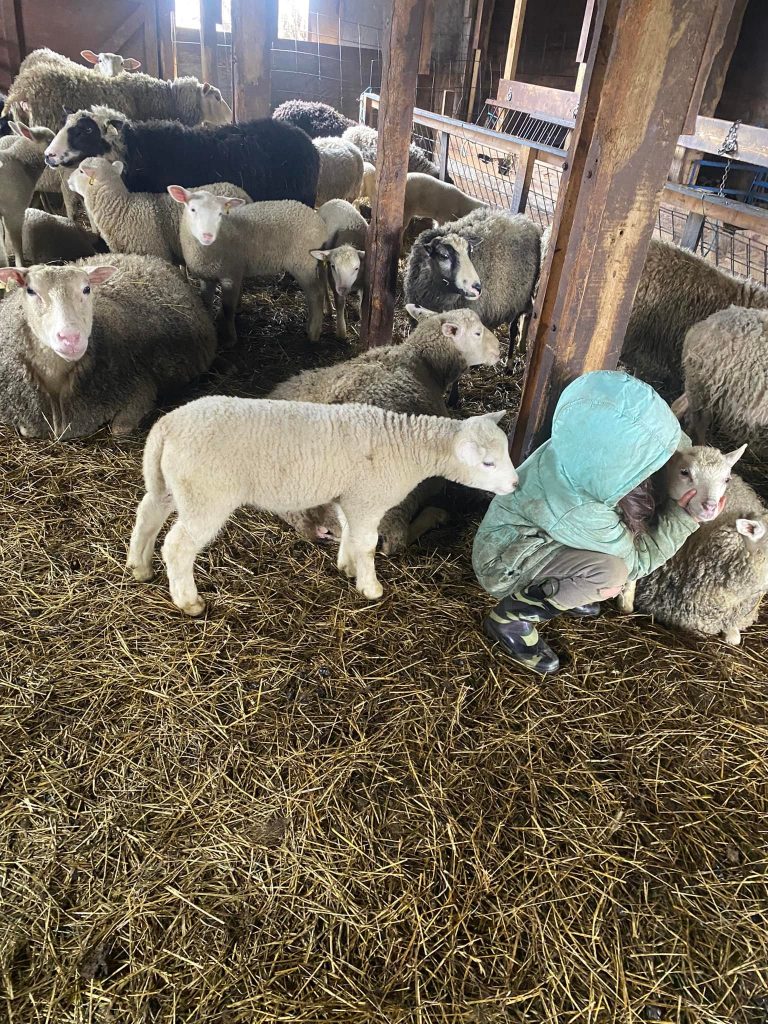Our 4th year of lambing out a flock of sheep has concluded. This year was MUCH smoother than the previous three – the lambs have been generally born healthy, strong, and without complications. There were three ewes who didn’t conceive, one lost pregnancy, one lost lamb, and 42 healthy, bouncing, fast-growing lambs.
I don’t know if I went into much detail about our former issues, but we were dealing with complications such as lambs born dead, vaginal prolapses, retained placentas, excessive malpositions, and then the results of those complications such as sick ewes, stressed, weak lambs, and inadequate milk production. We also had healthy lambs, but there were far more complications than in a typical flock.
I attribute our improved outcomes this year with the change in minerals we offer to the sheep. We had been feeding free-choice Sweetlix Lambmaker minerals from our local mill. After talking with a long-time breeder of Finnsheep, who had never seen, or even heard of this breed having the issues we were having, he recommended mineralized salt, so I decided to try the Premier1 trace mineral premix. It is mixed with plain salt, so doesn’t make them want to eat more than they need since it just tastes like salt. The Sweetlix minerals are ‘flavored for palatability,’ in other words, they taste good so the sheep eat more! The theory was that our sheep were consuming too much minerals, causing an imbalance, resulting in the complications.
Since vaginal prolapses were our most pervasive and perplexing issue, I’m going to go into a little more detail on our situation here, and what we did and why. The typical approach to vaginal prolapses is to remove offending ewes from the flock. After carefully analyzing our situation and discussing it with our vet, we strongly suspected that our prolapse problem was not of a genetic origin, so we did not cull the ewes who had manageable prolapses. (Notice, I said ‘manageable’. We did cull a promising young ewe who had had a bad enough prolapse we considered that it would be inhumane to take the risk of her suffering through that again.) With this mineral change, one of our previous offenders had so minimal of a prolapse that I wouldn’t have noticed had I not been watching her like a hawk. She also had more weight of lambs than in her previous two pregnancies(1/3 her body weight!), so logically she should have prolapsed more severely than before. The other offender did not conceive this year…so we wait until next year to to see if there is any change in her status. I do not expect them to revert back to NOT prolapsing; from what I’ve read, once there is a vaginal prolapse, those ligaments and muscles are damaged and will no longer properly retain the vagina under the pressure of pregnancy. We have retained a number of daughters from ewes who have prolapsed, and none of them have done so. If you are interested in discussing this topic or would like more details, feel free to get in touch!
On a lighter note, we had retained 5 Texel/Finn ewe lambs last year to see how they would perform as production dams. We have been very pleased, and intend to retain all the decent cross ewes from this year too. The TexelX ewes all conceived to lamb at 1 year old, were perfect mothers, easily lambed(except for the ewe with the 12 lb lamb, but she was fine with some assistance!), and have been raising beautifully fat lambs. They are more thrifty and parasite resistant than the Finns, and are calm, friendly ewes. Honestly, my very favorite is a Texel/Finn/Shetland yearling. She had beautiful twins, was in very good condition when her peers were just ok, and is a good size. I know Shetlands traditionally don’t have any production value, but this girl’s dam has thriftiness and parasite resistance that she passed down, and THAT has value in our flock! She isn’t super small, and she raises fat lambs on par with our other sheep, so we will be crossing her with the Texel again for more hardy, thrifty, parasite resistant, meat producing ewes.
One of our TexelX ewes missed her date with the Texel ram and instead ended up with a 3/4 Finn lamb. He’s pretty goofy looking, but despite his low percentage of Texel, he is still beefier than the full Finn lambs. The rest of the X ewes had 3/4 Texel lambs, and they were all ewes! They are available, as we believe they will make good meat producing dams. We won’t be keeping them, as we have only one Texel ram, and don’t want to cross him over the same line again.


